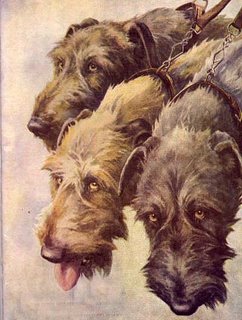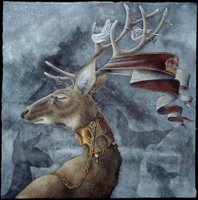Manies a time we hear tale of how the theft of a deerhound or hounds caused conflict in ancient times among the peoples, tribes, or clans of what we now know as Scotland. But amongst deerhound owners today, can any tell the tale, or have any heard or read any of the actual tales about the magnificent hounds and events that started these tales of legend.
Well the Rogue here, along with his human companions, their family, clan and friends have undertaken a quest to locate and to share with deerhound fans (and others that may be interested) their finds.
With these tales come some historical fact and I’ll let the sceptical and doubters research for fault among the tales I upload, but it should not be forgoten that these northern lands are steeped in tradition of great story telling.
Before we begin the story I would like to thank
Stuart McHardy for pointing me in the direction of this grand Pictish piece and anyone interested in enjoying the stories as they are meant to be enjoyed visit the
scottish storytelling centre site and become actively involved.
Or alternatively dig into some of the fine publications published by Luath Press which I shall feature on this blogspot as time blogs by.
Read on and enjoy . . .
War of the Hunting HoundBack in the time of the Picts, some of their kings were chosen from amongst neighbouring tribes. it is said this happened because the right to the Kingship came from marrying the queen of the Picts and it meant that sometimes whilst the Picts were at war with their neighbours, at other times they were at peace with them. It was in one of these periods of peace that a king of one of the neighbouring tribes, called Crathinluth, invited a band of young Pictish warriors to come and stay at his home of Dunadd in the Kilmartin Valley.
This neighbouring tribe like the Picts were a tribal warrior society and the chiefs tended to have a group of young warriors with them at all times. It was the accepted thing for young men to spend a period in their late teens as full-time warriors before settling down to married life in their community, and this had the added benefit of keeping troublesome adolescents busy. Young men have always had a tendancy towards what you can call ‘unfocused behaviour’, like mischief and just plain trouble. However, it was a great compliment to this particular band of young Picts to be asked to go and become a part of Crathinluth’s household, and of course the wisest peoples amongst both peoples thought it was a good idea that would help keep the current peace between them. But young men are prone to rash acts that, whilst they might start of as mischief, can quickly develop into something much more serious.
This band of Picts had been out with Crathinluth, hunting deer in the forests to the North of the valley, and a couple of them noticed how fond he was of one particular large dark rusty red hunting hound. One night after drinking deep of their favourite drink, the heather yill, which they had the unfortunate foresight to bring plenty of, they decided to play a trick on their host by taking his favourite hound and hiding it. they were successful in taking the dog and leading it to the edge of the wood where they themselves were camping out. however, Crathinluth’s hounds were under the charge of a very experienced old warrior who soon figured what had happened.

He managed to track the dog to where it was hidden and was just about to take it back when the handful of young picts came upon him. Words were exchanged, tempers rose, swords were drawn and things quickly went from bad to worse. Fired up with drink, and upset that the trick had been found out, one of the Picts made as if to attack the old warrior. At this the dog, which had stood quiet until now went for him. unthinkingly he stabbed the dog through the chest piercing his heart. the dogs guardian lunged forward and was struck down by the Pict companions! their mischief had indeed gone bad. The kings favourite hound and its keeper lay dead on the ground.
Realising the utter stupidity of their actions, the youths ran back to tell their comrades what had happened. there was little option. If they went to Crathinluth and admited what they had done, those that had spilt the old warrior’s blood were likely to lose their lives. there were only one or two older and more experienced amongst them and they agreed the only way out of this mess was to head back to the East as quickly as possible and try to come to an arrangement later. they hoped they would be able to make some sort of money settlement for the old man’s life. So, under cover of darkness the entire contingent of Picts slipped off through the forest and headed over Drumalbain. They left no one to tell their side of the story - a sad and costly mistake.
The following morning Crathinluth was told that the Picts had killed his trusted Master of Hounds and his favourite hound and then slipped of under the cover of darkness. this was a dreadful insult and at once he sent of a hand-picked band of experienced warriors to hunt them down. when they returned three days later, they reported that the Picts had managed to elude them after a short skirmish and returned home. However, in the fighting, warriors from both sides had been killed. At once Crathinluth sent word to the Pictish courts that the perpetrators were to be handed over, or else. As soon as the messenger was sent, Crathinluth started raising an army. Fine well he knew that if he wanted justice, he might well have to fight for it.
Back in Pictalnd, having told their sorry tale, the young band stressed that the pursuing tribe had killed two of their number. When the peremtory demand to hand the culprits over came, there were a few voices that urged calm and an attempt to negotiate. however, many of the Pictish warriors saw Crathinluth’s demands as an insult in itself and were all for defending there own. So the Pictish chiefs had little choice but to call together their own warriors and the scene was set for a battle. neither side was prepared to give way and the plans for peace from wiser heads on both sides were ignored. conflict was now inevitable and over the next couple of weeks small battles started to erupt through the border country between the two peoples. in these small battles more warriors lost their lives, stoking further resentment. things just got worse from there. the battles that were fought gradually involved greater numbers, and the numbers of the slain on each side continued to rise. both peoples were composed of warrior tribes and neither would even think of giving way - their honour demanded victory. the peace that had gone before was forgotten and the slaughter and anmity grew. it seemed as if the war would continue till one side was totally triumphant or all the warriors on both sides were dead.
The wiser, older men and woman who realised the stupidity of the war were at their wit’s end. they knew they could only bring the fighting warriors to their senses by finding someone both sides could respect, that they both might listen to. But with the whole country in arms and all the tribes on one side or another, who could they call on? one of the elder Picts, an adviser to the queen, suggested a wrrior that had the respect of both sides. Both sides had fought against this man and had respect for him. at last a possible candidate for referree was found. So word was sent South to the great fort on the Mighty wall the Roman legions had built from the sea to sea across the country. There a message was given to Carausius, the famous Roman who had come over from Armorica on the continent to defend the wall. Here was someone who had the respect of all the warring tribes, even if they would all be glad to see the back of him and all his foreign troops.
Carausius was astounded. these barbarians, as the Romans saw them, were attacking each other and making his life easier. whilst they were distracted they would not be harrying his troops. however, although he had been a soldier for many years, and taken part in many brutal campaigns for the Roman Senate, in his heart he was a fair and honest man. he told the Pictish messengers he would think about what the proposed and would let them know within a few days. Though it caused him several sleepless nights this veteran roman at last decided that he would try to do what he was asked, and sent word to the leaders of both peoples.
Astounded at this intervention both Crathinluth and his opposite number, Drest, agreed to meet with the Roman leader on neutral ground far to the south, near to the wall itself. And here under the careful diplomacy of Carausius the two peoples were persuaded of the folly of carrying on the fighting. it was only at this fateful meeting that Crathinluth heard what had actually happened and on considering the cost of what had surely been little more than stupidity on behalf of the young pictish band he agreed that the talk of peace was desirable. And so it was that the war of the hunting hound, with the help of a Roman general came to an end. And so it was that all sides set aside their differences and entered into a brief period of peace.











